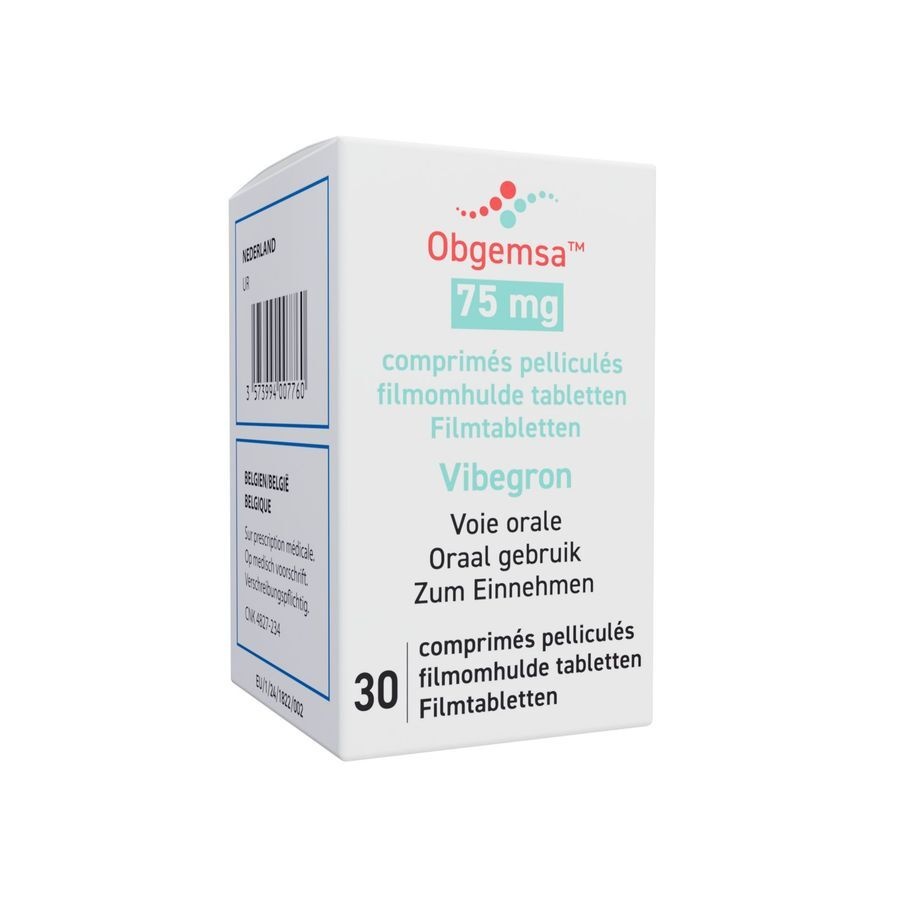

OBGEMSA 75 mg FILM-COATED TABLETS

Ask a doctor about a prescription for OBGEMSA 75 mg FILM-COATED TABLETS

How to use OBGEMSA 75 mg FILM-COATED TABLETS
Introduction
Package Leaflet: Information for the Patient
Obgemsa 75 mg film-coated tablets
vibegron
This medicinal product is subject to additional monitoring, which will allow for quick identification of new safety information. You can help by reporting any side effects you may get. See the end of section 4 for how to report side effects.
Read all of this leaflet carefully before you start taking this medicine because it contains important information for you.
- Keep this leaflet, you may need to read it again.
- If you have any further questions, ask your doctor or pharmacist.
- This medicine has been prescribed for you only. Do not pass it on to others. It may harm them, even if their signs of illness are the same as yours.
- If you get any side effects, talk to your doctor or pharmacist. This includes any possible side effects not listed in this leaflet. See section 4.
Contents of the pack:
- What is Obgemsa and what is it used for
- What you need to know before you take Obgemsa
- How to take Obgemsa
- Possible side effects
- Storage of Obgemsa
- Contents of the pack and other information
1. What is Obgemsa and what is it used for
Obgemsa contains the active substance vibegron. It is a medicine that relaxes the bladder muscle (called a beta-3 adrenergic receptor agonist) that reduces the symptoms associated with an overactive bladder and treats related symptoms.
Obgemsa is used to treat symptoms of overactive bladder in adults who:
- suddenly need to urinate (called urgency)
- need to urinate more often than normal (called increased urination frequency)
- are unable to control themselves when their bladder is full and urinate involuntarily (called urge incontinence)
2. What you need to know before you take Obgemsa
Do not take Obgemsa
- if you are allergic to vibegron or any of the other ingredients of this medicine (listed in section 6).
Warnings and precautions
Talk to your doctor or pharmacist before taking Obgemsa:
- if you have problems emptying your bladder or have a weak urine stream or if you are taking other medicines for the treatment of overactive bladder such as anticholinergic medicines, for example, oxybutynin, diphenhydramine, solifenacin.
If you have severe liver problems or if you have end-stage renal disease, as Obgemsa should not be used in these cases.
Children and adolescents
Do not give this medicine to children and adolescents under 18 years of age because the safety and efficacy of Obgemsa in this age group have not been established.
Other medicines and Obgemsa
Tell your doctor or pharmacist if you are taking, have recently taken or might take any other medicines.
Tell your doctor if you are using digoxin (a medicine for heart failure or heart rhythm disorders). Your doctor will measure the levels of this medicine in your blood. If the level in your blood is outside the permitted range, your doctor will adjust the dose of digoxin.
Tell your doctor if you are using dabigatran etexilate (an anticoagulant), apixaban (an anticoagulant), or rivaroxaban (an antithrombotic). These medicines may require dose adjustments by your doctor.
Pregnancy and breastfeeding
Women of childbearing age
If you think you might be pregnant or are planning to become pregnant, you should not take Obgemsa. It is not known how this medicine could affect the fetus.
Pregnancy
If you are pregnant, you should not take Obgemsa. It is not known how this medicine could affect the baby.
Breastfeeding
It is likely that this medicine will pass into breast milk, but the risks to the baby are not known. Therefore, you should not breastfeed while taking Obgemsa.
Driving and using machines
Obgemsa has no or negligible influence on the ability to drive and use machines.
Obgemsa contains lactose
If your doctor has told you that you have an intolerance to some sugars, consult them before taking this medicine.
Obgemsa contains sodium
This medicine contains less than 1 mmol of sodium (23 mg) per tablet; this is essentially "sodium-free”.
3. How to take Obgemsa
Take this medicine exactly as your doctor has told you. If you are not sure, ask your doctor or pharmacist.
The recommended dose is 1 tablet a day.
Swallow the tablet with a glass of water. If necessary, the tablet can be crushed and mixed with 1 tablespoon (about 15 ml) of soft food (e.g., apple sauce). Eat the mixture and then drink a glass of water. Once mixed with food, it should be taken immediately. You can take the tablet with or without food.
If you take more Obgemsa than you should
If you take more tablets than you should, or if someone else takes your tablets by mistake, contact your doctor, pharmacist, or hospital immediately. Symptoms of overdose may include gastrointestinal problems, headache, and difficulty breathing.
If you forget to take Obgemsa
If you forget a dose, take the next dose normally the next day. Do not take a double dose to make up for forgotten doses. If you forget several doses, talk to your doctor and follow their advice.
If you stop taking Obgemsa
Do not stop taking Obgemsa early if you do not see an immediate effect. Your bladder may need time to adjust, and you should continue taking your tablets.
Do not stop taking Obgemsa when your symptoms improve, as the symptoms of overactive bladder may return. Talk to your doctor before stopping Obgemsa.
If you have any other questions about the use of this medicine, ask your doctor or pharmacist.
4. Possible side effects
Like all medicines, this medicine can cause side effects, although not everybody gets them.
A rare side effect (may affect up to 1 in 100 people) is the inability to empty the bladder (urinary retention). Obgemsa may increase the likelihood of not being able to empty the bladder, especially if you have an obstruction of the bladder outlet or are taking other medicines for the treatment of overactive bladder. If you are unable to empty your bladder, inform your doctor immediately.
Other side effects are:
Common side effects(may affect up to 1 in 10 people)
- headache
- diarrhea
- nausea (feeling sick)
- constipation
- urinary tract infection (infection of the structures that carry urine)
- increased residual urine volume (increase in the amount of urine left in the bladder after voluntary urination)
Uncommon side effects(may affect up to 1 in 100 people)
- flushing
- urinary retention, including intense straining to urinate (inability to empty the bladder)
- rash (including itchy rash and red rash)
Reporting of side effects
If you experience any side effects, talk to your doctor or pharmacist, even if they are not listed in this leaflet. You can also report side effects directly via the national reporting system listed in Appendix V. By reporting side effects, you can help provide more information on the safety of this medicine.
5. Storage of Obgemsa
Keep this medicine out of the sight and reach of children.
Do not use this medicine after the expiry date which is stated on the carton or bottle after EXP. The expiry date is the last day of the month stated.
This medicine does not require any special storage conditions.
Medicines should not be disposed of via wastewater or household waste. Ask your pharmacist how to dispose of medicines no longer required. This will help protect the environment.
6. Contents of the pack and other information
Composition of Obgemsa
- The active substance is vibegron. Each film-coated tablet contains 75 mg of vibegron.
- The other excipients are:
- Core of the tablet: mannitol, microcrystalline cellulose, sodium croscarmellose, hypromellose, and magnesium stearate. See section 2 "Obgemsa contains sodium".
- Coating: aluminum lake indigo carmine (E132), hypromellose, yellow iron oxide (E172), lactose, titanium dioxide (E171), and triacetin. See section 2 "Obgemsa contains lactose”.
Appearance and packaging
The film-coated tablets are light green, oval, and have the inscription V75 on one side and are smooth on the other. The tablet measures approximately 9 mm (length) x 4 mm (width) x 3 mm (height).
Obgemsa is available in white plastic square or round bottles with a child-resistant plastic cap.
Pack sizes of 7, 30, or 90 film-coated tablets.
Not all pack sizes may be marketed.
Marketing authorization holder
PIERRE FABRE MEDICAMENT
Les Cauquillous
81500 Lavaur
France
Manufacturer
PATHEON FRANCE
40 boulevard de Champaret
38300 Bourgoin Jallieu
France
PIRAMAL PHARMA SOLUTIONS (DUTCH) B.V.
Bargelaan 200
Leiden, 2333 CW
Netherlands
Date of last revision of this leaflet:
Other sources of information
Detailed information on this medicine is available on the European Medicines Agency website: http://www.ema.europa.eu.
On the European Medicines Agency website, you can find this leaflet in all languages of the European Union/European Economic Area.
- Country of registration
- Active substance
- Prescription requiredYes
- Manufacturer
- This information is for reference only and does not constitute medical advice. Always consult a licensed doctor before taking any medication. Oladoctor is not responsible for medical decisions based on this content.
- Alternatives to OBGEMSA 75 mg FILM-COATED TABLETSDosage form: MODIFIED-RELEASE TABLET, 50 mgActive substance: mirabegronManufacturer: Laboratorios Alter S.A.Prescription requiredDosage form: MODIFIED-RELEASE TABLET, 50 mgActive substance: mirabegronManufacturer: Astellas Pharma Europe B.V.Prescription requiredDosage form: MODIFIED-RELEASE TABLET, 15 mgActive substance: darifenacinManufacturer: Aristo Pharma GmbhPrescription required
Online doctors for OBGEMSA 75 mg FILM-COATED TABLETS
Discuss dosage, side effects, interactions, contraindications, and prescription renewal for OBGEMSA 75 mg FILM-COATED TABLETS – subject to medical assessment and local rules.






